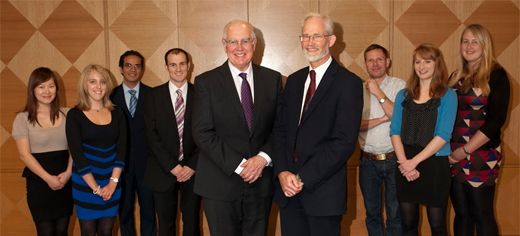
The University of Leeds and multinational consumer goods company Procter & Gamble (P&G) have signed a strategic agreement that will harness academic research to develop new high-tech products.
P&G and the University have a longstanding partnership, with more than 20 joint research projects currently under way, but the new Declaration of Strategic Relationship will more thoroughly integrate the two organisations’ planning and operations.
Sir Alan Langlands, Vice-Chancellor of the University of Leeds, said: “This is a new way of getting University researchers and industrialists working together. The objective is to build teams across both organisations that can respond very flexibly to business, research and educational opportunities.”
A distinctive feature of the partnership is its innovative approach to getting collaborations working on the ground.
Within P&G, a dedicated Connect+Develop Board—part of the Company’s commitment to open innovation collaboration— identifies the potential academics partners for key projects, while university researchers also are encouraged to approach P&G with ideas. With intellectual property and confidentiality issues already covered by the strategic partnership agreement, work can get under way quickly.
“We can get a sub-agreement for a specific project in place within a couple of weeks,” said Dr Hossein Ahmadian, relationship manager from P&G. “From a timing and logistics point of view, that speed of start-up is invaluable.”
P&G’s joint projects with Leeds include more than a dozen PhD and post-doctoral projects, but the partnership also gives the company broader access to expertise across the university.
An innovative P&G Simulation Centre, based on the University’s campus, recruits final-year PhD students from a variety of disciplines to work on 20-hours-a-week, six-month contracts on projects for business units across the company. Students are recruited because they have relevant expertise to a project and are often not working with P&G in their full-time research. For example, Fernando Zapata Cornelio, a PhD student looking at bone fractures in the University’s School of Mechanical Engineering, is working on razor blades at the centre.
Sandy Black, 25, a PhD student in the University’s School of Process, Environmental and Materials Engineering, is applying his knowledge of modelling combustion to the storage of liquids by P&G.
“The work with P&G is allowing me to broaden my experience beyond my particular research area. I am using new tools and developing an understanding of working in industry and the pressures and timescales you are expected to work to. I talk to my P&G supervisor in Brussels by webcam every week and work on the P&G computer system. I really am part of their team,” he said.
Under the agreement, P&G and the University will identify strategic research themes across a wide range of academic disciplines including engineering, maths and physics, design, computing, chemistry, psychology, business and the arts. The University will develop capacity to meet long-term P&G priorities and is drawing up a five-year plan including targets linking the work done at Leeds to the value of the company’s commercial products. The company will encourage all relevant business units to use the University’s expertise in the strategic areas.
Charles Bragg, R&D Site Director at P&G's Newcastle Innovation Centre, said: “The benefits to P&G have not only been the expected unique inputs to solutions for our technical problems, but also the development of innovation capability in our businesses, potential intellectual property and training opportunities for our staff. What has particularly impressed us is the speed with which projects are established and the level of industrial know-how the academics possess. They are very interested in our technical problems, given that they are usually at the cutting edge of research. This is highly advantageous for a fast-moving consumer goods company like P&G."
Professor Peter Jimack, Dean of the University of Leeds’ Faculty of Engineering, said: “When you are doing ad hoc projects everything is reactive. This relationship provides the opportunity to plan ahead and, because we are working together from an early stage, to take on bigger projects and do them better. The work with P&G has until now been focused around particle science and engineering but there is world-leading expertise across the University. We are promoting these strengths within P&G and exploring projects that will allow our partnership to broaden in a manner that will benefit both P&G and the University.”
Sir Alan and Mr Bragg signed the Declaration of Strategic Relationship at the University on October 11.
Mr Bragg has another connection to the University. His great-grandfather was Professor William Henry Bragg, who, with his son William Lawrence Bragg, was awarded the Nobel Prize in Physics in 1915 for the development of X-ray crystallography at the University.
Image information: Sir Alan Langlands, Vice-Chancellor of the University of Leeds ( centre, left) and Charles Bragg, R&D Site Director at P&G's Newcastle Innovation Centre (centre, right) with researchers working on P&G projects at the University.
Further information
University of Leeds contact: Chris Bunting, Press Officer, University of Leeds; phone:+44 113 343 2049 or email c.j.bunting@leeds.ac.uk
P&G contact: James Williams, P&G Corporate Communications; phone +44 1932 896 483 or email williams.j.38@pg.com